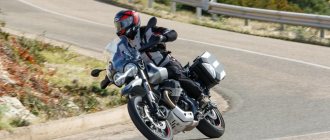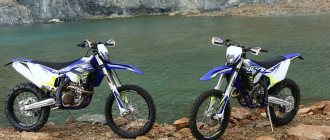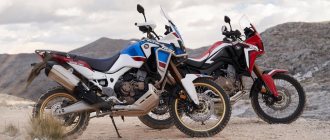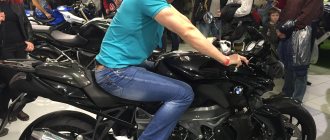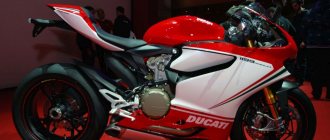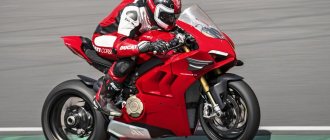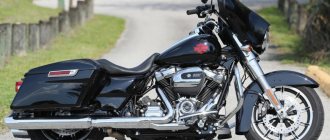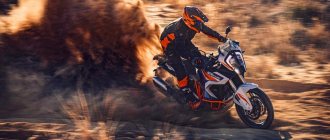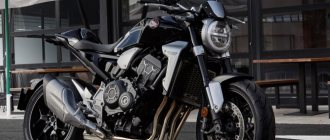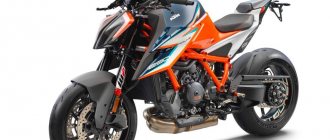First Impressions of the 2019 Honda Super Cub
In 1959, Honda established its first North American headquarters in Los Angeles. Only 11 years after the creation of the Japanese company, entry into the American market became Honda's bid for leadership in the world market, and this began with the American success of one of the mass Japanese models - the Honda Super Cub.
Honda Super Cub C50, carburetor
The classic cab was produced in this form for many years: from 1982 to 2011. There is a lot of information on it in the knowledge base. Its entire body, except for the sail and covers, is made up of a solid iron frame. Its appearance is a true classic that is eye-catching.
What about spare parts:
normal selection of spare parts everywhere: from alpha on the Russian market, originals to the smallest parts in Japanese stores. Even the most damaged engine can be easily restored: cylinder head, CPG, sprockets, repair kits, gaskets and everything else comes from alpha. You can put a larger head and carburetor, find an exhaust with a wide hole. In addition to the engine, there are many identical spare parts in the chassis. Inexpensive and available. If you leave it in factory condition and do not tune anything, it will not cause any problems - you just need to periodically service it.
Model features:
the most basic cab, which hereinafter I will call “classic”.
Honda Super Cub C50 with carburetor
Honda Cub engine tuning
Today, on the Russian market, “fifty dollars” are a dime a dozen. There are countless options for used “Japanese” and new “Chinese” ones, but almost all of them are with an ancient, reliable, but not very powerful “Honda” four-stroke. Meanwhile, adding a fresh horse to a frail team is not too difficult. And not too expensive.
It's no secret that the most common motorcycle engine in the world was designed by Honda half a century ago for the legendary Super Cub scooter. However, today we are not talking about the illustrious veteran (Russia, oddly enough, has bypassed the most popular device in the world), but about its multiple Chinese clones, of which there are many on our market: they are installed on mopeds sold under a dozen brands, children’s quads, mini -bikes, cross-country bikes and scooters. Mostly, they bring to us vehicles with 50 cc engines (their designation is standardized among the Chinese - 139RM), which fall into the coveted “moped” category. And it’s easier for sellers: they don’t have to worry about PTS and meticulous certification.
The dimension of the “fifty kopeck” is 39 x 41.5 mm (cylinder diameter per piston stroke), and in the standard configuration it is capable of producing, depending on the degree of boost, from 1.75 to 3.5 hp. At best, mopeds, scooters and minibikes with such an engine accelerate to 65-75 km/h, and at worst - only up to 50 km/h. Not everyone is satisfied with such modesty, and the search for a “cure” begins, which is described by the short and exciting word “tuning”. Without going into the moral and legal nuances of the issue (tuning “fifty dollars” is almost universally overlooked), we’ll tell you how to take the very first step in this direction, with minimal replacements and costs.
In general, “Kab” tuning abroad is as inexhaustible as an atom, and even the first “whales” (sets of parts) have already reached us. However, let’s not rush to do everything at once: the simplest and at the same time effective step is to switch to a cylinder diameter of 7 mm (with the same piston stroke, that is, without changing the crankshaft), which will provide a cubic capacity of 72 cm3. Here again, there are several kits available from different manufacturers. All of them provide, in addition to the inevitable replacement of the cylinder and piston, the replacement of the cylinder head assembly and carburetor. The last two nodes double the cost of the hardware (a new head will cost about 3,500 rubles). It is not possible to change the “head” for the reason that the 50 cc combustion chamber has a small volume and the tuning piston comes into contact with it.
It would seem that nothing can be done; you will have to buy an expensive kit. However, Evgeny Kuzmin from the workshop of the St. Petersburg salon “S-Moto” found a way to avoid replacing the cylinder head and carburetor. To do this, he uses a piston not from a tuning kit, but from... a scooter. It turns out that Chinese four-stroke scooter engines (by the way, also cloned from Honda) have tuning pistons of the same diameter and pin size, but the piston height is smaller. In addition, the scooter piston has a slightly concave bottom - this allows it to be used on “Kab” engines.
There are other advantages: the piston and pin are lighter compared to standard ones, that is, they are designed for higher speeds and hold the load better.
The work described below is valid for almost all Chinese “Cab” clones, regardless of the manufacturer. In any case, we are not aware of any “contraindications” or “inconsistencies”. Typically, parts from all manufacturers are completely interchangeable; CPG and timing parts do not have any size groups and, accordingly, the need for selective assembly. That is, any part from any manufacturer should, in theory, be suitable for any similar motor. However, there are exceptions to almost every rule, so it’s worth measuring the parts in any case.
The work with the scooter motor is discussed below; their peculiarity is that there is no need to disconnect the power unit from the frame; it is enough to remove some of the linings. Another preparatory operation is cleaning the motor. An aerosol engine cleaner will help speed it up. After applying the solution, you need to let it absorb, and then you can rinse it off with water. Particular attention should be paid to ensure that no dirt remains on the upper horizontal surface where the cylinder meets the engine crankcase - sand from there can directly get into the crankcase.
When disassembling the timing belt and CPG, it is convenient to put fasteners and parts of different components in separate cells so as not to get confused during assembly. You can use, for example, an egg carton, but I made a block by wrapping cut baby food cans with tape - it turned out to be extremely convenient. Another important piece of advice is that “Cab” (and indeed any) engines have many details that are similar in appearance, but differ in small details, and if they are mixed up, the consequences can be depressing. To prevent this from happening (especially if some unit is being disassembled for the first time), we recommend that you sketch or photograph the location of the parts, and also write down the disassembly sequence - where are the screws, bolts, and washers from?
The most common and costly mistake when working with a four-stroke engine is incorrect valve timing. If you “miss” the phases, you won’t be able to start the engine (but that’s not so bad), it’s worse when the valves meet the piston! Therefore, manufacturers apply special marks to parts. There are two pairs of marks: one on the generator rotor and crankcase, the other on the drive gear and cylinder head. To make it easier to rotate the crankshaft using a wrench with a head placed on the rotor nut (to do this, unscrew the hatch in the generator cover), you should unscrew the spark plug.
There are several marks on the rotor, we need “T” (Top or TDC), it should be located strictly in the middle of the inspection hatch in the upper part of the crankcase. The second pair of marks will be visible if you remove the characteristic round cover on the head (by unscrewing the bolt whose head is located on the opposite side - there are two more bolt heads, but the one needed is closer to the spark plug). At the camshaft drive sprocket, the stamped circle should be located opposite a small hole oriented forward. Since the gear ratio in the timing drive is :2, not every position of the piston at TDC (mark T) will correspond to the desired valve timing. If the mark is not visible, the crankshaft will have to be turned one more revolution.
The tags are set, you can sort everything out in order. We unscrew the three bolts securing the timing sprocket (for this you will need a “9” head). To make the exhaust pipe fastening nuts easier to unscrew and the threads not to suffer, it is advisable to saturate the connection with a penetrating lubricant. We unscrew the bolts securing the inlet pipe and tie it to the frame together with the carburetor. There is no need to disconnect anything else from the “hitch”. Now it’s the turn of the four cap nuts from the end of the head; they press the head to the cylinder, and that to the crankcase. Pay attention to the breaking force - you will have to tighten them with approximately the same (but no more!) (however, we strongly recommend using a torque wrench or at least a steelyard with a measured wrench - its accuracy is quite sufficient). Below them is the first nuance: not all washers are the same, one of them is copper. Remember its location - the lower right stud; oil flows through its channel into the head to lubricate the parts. There is an arrow on the head cover, which is now freed, (since the location of the pins is asymmetrical), and it should be directed downward during assembly. Another nuance: between the cylinder and the crankcase and between the cylinder and the head there are guide bushings; they are different in height. It’s easy to remember where it is: since the gasket under the head is thicker, the bushings there are longer.
We remove the timing sprocket to the side and remove it from the chain, unscrew the guide roller axis and remove the roller. There is an aluminum washer under the axle head, which should also not be confused with the others. At the junction between the head and the cylinder on the lower right channel we will find a sealing rubber and a centering sleeve. The joint between the cylinder and the crankcase is also sealed. During assembly, we install new rubber bands (three pieces) in their places. Carefully pull the cylinder along the studs, then remove the piston pin and remove the piston. Before using an awl or a screwdriver to pick up the piston pin retaining ring, it is advisable to cover the crankcase “jaw” with some clean cloth. Just in case…
Now let's move on to the preparatory operations. First of all, we clean the crankcase seating joint, as well as the two planes of the head from which we removed the covers - often fragments of the old gasket, or even the entire gasket, remain there. In any case, we change the gaskets; to remove old ones, it is best to use a modern product - an aerosol “Gasket Remover”. Having sprayed the product, let it “work” for 10-15 minutes, after which the old gasket is easily removed using a scraper or a utility knife blade.
When installing a new piston, pay attention to the inscription 1п(а1<е (“Inlet”), it should be at the top. Liberally lubricate the pin, piston, and rings with engine oil. The cylinder a little later - you must first degrease it: remove the preservative grease and use a rag to moistened with gasoline, remove the remaining abrasive from processing. We put the first lock ring in the piston (experienced mechanics advise removing the tendril with pliers - for reliability, often the tip of the tendril comes out and begins to lift the surface of the cylinder), then the pin and the second lock ring. Separate the cuts of the piston rings: 180° halves of the oil scraper, and another 180° cuts of the compression rings.
The rest of the assembly is carried out in reverse order. But there are a couple of “ambushes” here: firstly, let’s not forget about guide bushings of different heights and new rubber rings. Secondly, and this is very important, by threading the timing chain back into the cylinder cavity, we will make sure that the chain is correctly positioned relative to the plastic gear, which stands deep in the crankcase and is responsible for tensioning the chain. Otherwise, the chain may slip past, which can lead to the destruction of the gear or even breakage of the chain (and then the valves are screwed up).
Having placed the head on the studs (not forgetting about the damper roller first), we install the timing sprocket: we pull it from the bottom of the window, overcoming the force of the chain tensioner. We definitely check that the timing marks match (see above), because a mistake of two teeth can already lead to valve failure. At the same time, while the engine is cold, we check the valve clearances: they should be from 0.05 to 0.07 mm. Tighten the cylinder head nuts evenly, crosswise, in two or three passes. We control the final tightening force with a torque wrench; the torque is approximately 10-14 Nm. The exact value can be found in the specific manufacturer's repair manuals. And one more thing: do not forget to fill in new oil if you drained the old one. In general, “Kab” engines are extremely unpretentious to the oils used, the main condition is that there is oil there. After tuning, during extreme driving in the heat or in the city, it is advisable to use motorcycle oils with a viscosity of at least 10\L/iO. And lastly: after such a boost, the compression ratio increases to 10.6-10.8, so it is necessary to use 95 gasoline.
Honda Super Cub C50, injector 2007-2012
The second participant is the injection Super Cub. Its main feature is the PGM-Fi injection system. It consists of a pump, nozzle, electronic control unit and sensors. It starts well in any weather, eats less, injection does not need to be adjusted. But there are also disadvantages: the catalyst eats up part of the power - due to this, injection mopeds are slightly less powerful than carburetor ones. There are also a lot of sensors on the moped that can be damaged. But there is also convenience: it has an indication of low fuel and there is no need to switch from the main tank to the reserve. Not an obvious plus: the injector hardly smells of gasoline.
What about spare parts:
Unfortunately, the injection engine is not covered by spare parts from Alpha: it has its own cylinder head and CPG, and injection system. Tuning kits are sold by SP Takegawa, Kitaco, Minimoto, these cost from $250. There are no differences in the chassis from the carburetor - much will be suitable from the Alpha.
Model features:
The easiest way to distinguish an injection model is by the black color of the engine. There are check engine and low fuel indicators under the speedometer.
Honda Super Cub C50 with fuel injection. The most notable difference is the black paint on the engine and the Check Engine under the speedometer.
Honda Press Cub C50, postal version
Postal version with increased load capacity. It’s called postal, but it was used in any area where delivery was needed. From 1988 to 2007 it was carburetor, in 2007 and 2008 it was produced with an injector. The most common option that is brought to Russia. The reason for its popularity is the low price in Japan due to the high mileage that is sold in Russia. Typically, mileage at auctions is 60-80 thousand kilometers, and in Russia 10-15 thousand kilometers.
What about spare parts:
Often they import injection ones - spare parts from Alpha are not suitable for them. The main problem is to buy rear wheel dampers and a rear sprocket. The dampers are only from Japan, and the star is JT in Russia or the original from Japan.
Model features:
The main headlight and turn signals are located in front of the trunk; a side light is located on the steering wheel. Two large trunks front and rear. The entire rear axle is reinforced: rim width 1.4, thicker spokes, thicker axle and bearings, larger pads, larger wheel dampers, its own rear sprocket.
The Honda Press Cub C50 was available with both a carburetor and an injector. The latter are more common here
Honda Super Cub C50 Custom, rich in options
It was produced in parallel with the cab with round headlights, but in a fatter configuration. Apart from its appearance, it is the same cab as its round relatives.
What about spare parts:
Everything is fine with spare parts for the engine, but problems may arise with spare parts for the external appearance - such a cab is almost never disassembled.
Model features:
square, 4 gears, electric starter, fuel level indicator on the dashboard. The front fork has an anti-lift mechanism.
Honda Super Cub C50 Custom
Kaba philosophy
All the events that happened during the time I owned the hole influenced or awakened my attitude towards life. Some people lack volume and want to increase it with power kits. But all this leads to expectations that the cab does not fulfill. People rarely get pleasure from increasing their cubic capacity, because it does not give the desired effect. Kab is a philosophy. He is leisurely and will do if you are not in a hurry either. If what you're looking for is a simple, easy-to-maintain short-distance vehicle, then this is your candidate.
For me, the cab became a symbol of my freedom of movement. It requires a minimal amount of money for maintenance, minimal equipment, and all this creates a very easy feeling - sit down and go. The Cub forgives a lot of mistakes that a heavier bike will not forgive. It is light and this plays a role not only off the road, but also when in the city, in a parking lot, you want to move it to another place.
Last photo for sale of my Press cab
Honda Super Cub C90, carburetor
A cab that allows you to calmly drive in traffic and start with a lead at a traffic light, and also not slow down on an ascent. You can ride with a passenger - there is a factory seat for the trunk.
What about spare parts:
almost everything is as good as the classic C50, but the CPG from the alpha will not work. You need to either install a Chinese 110 cm³ CPG, or order an original piston and rings.
Model features:
speedometer up to 80 km/h, 1.4 rims front and rear, reinforced rear shock absorbers, passenger footrests on a pendulum. There were no injection ones.
Honda Super Cub 90 with carburetor. Easily distinguished by the footpegs on the pendulum
I will describe my trip last year on this device along the Moscow-Black Sea route. Travel time is 2 weeks. Didn't set any records. I usually drove 300-400 km a day. The legendary old Honda Super Cub, produced in 1991. A legend in terms of reliability, indestructibility and the undisputed leader of all time in sales! Unfortunately, it is little known and little popular in Russia.
A little on the technical side and the reason for the choice. The reason for choosing “super cab”. Because I went a little into downshifting, then for me the main criteria were the following: 1) cost of operation (gasoline, oil, maintenance), 2) reliability and ease of maintenance - can also be attributed to the cost of operation, but there is also a very important parameter - failure rate, frequency and complexity of maintenance, 3) the possibility of use on the highway, as well as on light and medium off-road: not with the goal of pushing and messing with the shit, but simply driving along a path, a bad road, or light mud. 4) reasonable weight and dimensions: ease of driving in traffic jams, the ability to climb onto the curb, drag it (in extreme cases) indoors. 5) the ability to sharpen it for light tourism, and also use it for transporting small loads. I came across “super cab” by accident, read the information and watched the video and realized that this is what I need. I found an option on the Internet, went and bought it. I took the 4T (many recommended the 2T as more dynamic), and I don’t regret it, I did the right thing. 6) Lack of category “a” rights.
Disadvantages (purely IMHO) I will write everything that comes to mind, even a trifle. Maybe it will be useful to someone. 1) Sluggish front brake. As I later found out, this is the case with all Cubs. Suitable only as an extra. to the rear and for easy braking. But it is impossible to catch the blocking. 2) The length of the seat is a little short. I have a single-seater model with a large trunk. My height is 172 cm. The landing is very vertical. When driving for a long time (more than several hours), there is a desire to slide further back. This is prevented by the steel arch in the front of the trunk. There is indeed an overhead, removable seat for a second person. But I practically don’t use it, because... usually either a trunk or an empty trunk for cargo. There are models with a double seat, but then there is much less ability to transport cargo. 3) From the front, the Cub looks like some kind of simple moped, it is very narrow + a characteristic moped “non-aggressive” fit. There were a couple of times that the oncoming car did not understand my real speed and tried to turn left in front of me. Well, after riding later on different vehicles, I realized that this was not a Cub problem, but a general motorcycle problem. In general, the guys were very surprised that you were approaching them so quickly. We have to slow down. You have to be careful. Just like everywhere else. 4) It’s hard to find spare parts, especially in the regions. On the “139” engine - no problem, but the rest is a bit difficult. For example, the speedometer cable almost fits from the Chinese “delta”, but the fasteners need to be slightly modified, which was done.
I haven't remembered anything else yet.
Gasoline and oil consumption. Immediately after the purchase, while I was driving the cab calmly and leisurely at 40-50 km/h, the consumption was about 1 l/100 km. Oil was practically not consumed, at least for 1,000 km - there was practically no decrease in it. When I got used to it and started to burn it out (by this I mean that I almost constantly drove at full throttle, and not at high speed, of course) - the consumption became about 1.5 l/100 km. I started adding oil at approximately 100g/1000km. When driving on the highway for hours at full throttle (60 km/h uphill, 70-80 km/h straight and downhill), I added 100-200 grams of oil per day. with a daily mileage of 300-400 km. However, I used to have some kind of motorcycle oil, but I replaced it with synthetic car oil, which can be used up on an engine that is not new. Oil changes in 1.5 minutes. The drain plug is unscrewed and drained. A new one is being poured. All! Let's move on.
Choice of oil. After scouring the forums a bit, applying logic, and interviewing people familiar with the Kaboo engine, I made the decision to pour high-quality automobile oil into the engine. For me, it’s an additional convenience - there’s always oil left from the car, and it’s always much easier to buy car oil on the road. I started pouring Mobil super 3000 synthetic, taking into account that the engine is not new, I’m thinking of switching to semi-synthetics.
I looked at the required characteristics of the oil from the manual for the Super Cub; automotive oil fits the parameters well. I don’t want to raise a holivar on this topic. But the plus of cabbage is that its only requirement for oil is “it was wrong!”
I don’t want to raise a holivar on this topic. But the plus of cabbage is that its only requirement for oil is “it was wrong!”
General impression: Very pleased with the machine. The speedometer at the time of sale shows 27,800 km. I don’t know how twisted it is)) There are approximately 6-7000 of mine. After the trip the compression dropped. Dynamics and traction have dropped significantly. It accelerates to 60-65, but worse. It also gets worse when going uphill. I finished the season, and in winter I set it to 70cc, although as it turned out the problem was not in the piston and rings, but carbon deposits on the valves. Those. Cleaning and grinding could have been done.
The actual trip!
We left Moscow with a group, but on the very first day I realized that it was more convenient, more comfortable for me, and better for quality rest, to go alone, so I moved away from the company and continued driving alone. Again, one of the reasons for the trip is a midlife crisis, i.e. desire to rethink values alone. For this, the company is only a hindrance. The principle of my travel was “no tension” and to go “without thinking, but wherever you want.” And also, less people, more nature. Accordingly, the route was different. The camera was inconveniently packaged, so there are few photos, mostly from rest stops, where there was time to take it out and turn it on. I turned off my phone and didn’t look at my watch. I slept, ate and so on according to the sun and at will. Usually, when you get tired or the sun starts to go down, you think about where to pitch a tent. I turned on Yandex maps on my phone - I was looking for a lake or river, not very close to the road and villages. For some reason, it was nice to have a body of water nearby. I tried to drive 3-10 km from the highways, there are few people there, the lakes are clean, the prices in the stores are reasonable.
The first night I spent the night near Zadonsk, driving 10 km to the side. I made my way through the thickets to the place where I spent the night. This is the road to the lake. Before this, there were 500 meters across the plowed field - wet mud.
I went to Zadonsk in the morning. A very pleasant city, all dedicated to monasteries, temples, etc. I met a beggar from the porch, we talked behind the church, where is the priest, who is a true believer, and who earns his living by using the cross. He told everything, he laid everyone down! I collected water from the illuminated spring, but did not swim in the bathhouse - there was a certain queue.
A very pleasant city, all dedicated to monasteries, temples, etc. I met a beggar from the porch, we talked behind the church, where is the priest, who is a true believer, and who earns his living by using the cross. He told everything, he laid everyone down! I collected water from the illuminated spring, but did not swim in the bathhouse - there was a certain queue.
Then the fields of sunflowers began, very beautiful, I couldn’t stand it and went to look for mature sunflowers. The seeds were still small, but I found 6 bags of cucumbers, either hidden by someone or thrown into a field of sunflowers. I stocked up on cucumbers for the road. 
Then there was a short flight. Even with my low fuel consumption I flew on the highway. Filled up at the last minute. I passed 3 gas stations: 1 was on the other side of the road - too lazy to cross. 2 Similar 3 Reception and storage of fuel, they told me to wait 40 minutes - I didn’t want to wait. I drove on. And there's a racket at gas stations. I ran out of gas, filled it with NZ. NC ended. He stood up, opened the tank, and inserted an empty bottle so that everyone could understand the reason for voting. Cars are ignored and fly past. Either no one has gas, or I’m considered a guy from a neighboring village in my jalopy - maybe it’ll get there or the locals will come. ) After 30 minutes of standing on the road with my hand raised, Veterok (from the company with which I left Moscow together) caught up with me. He also decided to go autonomously. Filled up and we drove on that day together. Now I didn’t leave less than half a tank for myself!!!
Even with my low fuel consumption I flew on the highway. Filled up at the last minute. I passed 3 gas stations: 1 was on the other side of the road - too lazy to cross. 2 Similar 3 Reception and storage of fuel, they told me to wait 40 minutes - I didn’t want to wait. I drove on. And there's a racket at gas stations. I ran out of gas, filled it with NZ. NC ended. He stood up, opened the tank, and inserted an empty bottle so that everyone could understand the reason for voting. Cars are ignored and fly past. Either no one has gas, or I’m considered a guy from a neighboring village in my jalopy - maybe it’ll get there or the locals will come. ) After 30 minutes of standing on the road with my hand raised, Veterok (from the company with which I left Moscow together) caught up with me. He also decided to go autonomously. Filled up and we drove on that day together. Now I didn’t leave less than half a tank for myself!!!
We spent the night on a lake 5 km from the border with Ukraine. There are signs “border zone” everywhere.
In the morning we parted again. I was thinking about going to Ukraine, but... The rear camera began to poison and I pumped it up every 15-30 km, then I decided not to anger fate and move on. I poured in a liquid that seals small punctures - “0” to no avail. The phone sat down safely, the Yandex cards drained the battery mercilessly, and the charger from the moto battery burned out on the last day before leaving, according to the law of meanness. Therefore, when I saw the Bike Motel, I stopped by, where while I was drinking tea, my phone was charging at the reception. Because I went there in defense and the girl didn’t see what I arrived in, but I was greeted with attention and affection. The hotel is decorated superbly! Everything is very high quality and stylish! The owner, as I found out, is a biker.
I was thinking about going to Ukraine, but... The rear camera began to poison and I pumped it up every 15-30 km, then I decided not to anger fate and move on. I poured in a liquid that seals small punctures - “0” to no avail. The phone sat down safely, the Yandex cards drained the battery mercilessly, and the charger from the moto battery burned out on the last day before leaving, according to the law of meanness. Therefore, when I saw the Bike Motel, I stopped by, where while I was drinking tea, my phone was charging at the reception. Because I went there in defense and the girl didn’t see what I arrived in, but I was greeted with attention and affection. The hotel is decorated superbly! Everything is very high quality and stylish! The owner, as I found out, is a biker.
This is my older brother. He is on the move, goes to all sorts of bike events under his own power!
At the hotel I met a local young “biker” about 14 years old driving a Honda Dio. With the air of an adult, he scolded him for not having a helmet and mirrors on his moped. He nodded his head. I understand or not, I don’t know. They chatted about the motorcycles and I moved on.
Spent the night by the lake near Voronezh. In the morning the rear wheel was on the rim - I re-aligned the wheel and changed the tube. Everything turned out to be outrageously easy. You don't even need to remove the chain. The Japanese are great, and my model is clearly not for records, but for convenient and constant use.
The temple is on the road through Timashevsk, where I lost my way and went to the side. Here I received a fine of 200 rubles for a burnt-out headlight. The guys themselves were surprised that I stopped. I stopped and warmed up. The Gaians asked about weapons. then is there a knife? I said of course I have a knife, but what do you think, I’m traveling. :) They laughed and I moved on. Locals don’t even know what protection is. Even a helmet.
Here I received a fine of 200 rubles for a burnt-out headlight. The guys themselves were surprised that I stopped. I stopped and warmed up. The Gaians asked about weapons. then is there a knife? I said of course I have a knife, but what do you think, I’m traveling. :) They laughed and I moved on. Locals don’t even know what protection is. Even a helmet.
I stopped by the church and then to the honey fair! There I took honey in honeycombs and homemade yeast-free bread. They were enough for me for 2 days. In Krasnodar I stayed with a friend, he lives on the first floor, so they dragged the mot home for the night. Envy the bikers))) During the day I walked around Krasnodar with a drinks vending machine. The price of any is 10 rubles. There are 2 of them to choose from: kvass or lemonade!
There I took honey in honeycombs and homemade yeast-free bread. They were enough for me for 2 days. In Krasnodar I stayed with a friend, he lives on the first floor, so they dragged the mot home for the night. Envy the bikers))) During the day I walked around Krasnodar with a drinks vending machine. The price of any is 10 rubles. There are 2 of them to choose from: kvass or lemonade!
I didn't understand right away :)
Novorossiysk: The climb is steep. In some places I was in first gear.
Above Novorossiysk - the serpentine road is quite high - I went to look for the spring that the oil depot guard had told me about.
I found a spring. Awesome nature, but the number of mosquitoes is outrageous. I quickly ate and went straight to the tent, because... The shovel has already begun to break on the mosquitoes. Locals take tourists for rides through these wilds in UAZs. Kind of like a “wilds tour”. When the UAZ drivers saw me on a moped, they were very surprised. I asked where the spring was. They indicated the direction and began to argue loudly behind their back whether I would get there or not. The main thought was: well, I got here. 
A broken road to the sea near Kabardinka. Only me and a Padzherik three-door made it here - the road was terrible. I drove for a long time through terrible gullies. But the view is simply unrealistically beautiful. I lost my water bottle along the way, so I had to go back and look for it. The second time it was uninteresting and long to return, so I moved on.
The seashore near Taganrog. There are no people left or right at all. Only in the morning and evening did the shepherd drive his flock past me. In the middle of the photo you can barely see the moped.
There are no people left or right at all. Only in the morning and evening did the shepherd drive his flock past me. In the middle of the photo you can barely see the moped.
Monument to a merchant in Rostov - it says “trade honestly - you will make a profit”
An opportunity arose to return and decided to go by bus. The asking price is 1300 rubles, 500 rubles for a scooter to Moscow. Disassembling the scooter for the road. He climbed onto the bus not even sideways, but straight on the wheels. He was leaned against the side and covered with boxes.
The asking price is 1300 rubles, 500 rubles for a scooter to Moscow. Disassembling the scooter for the road. He climbed onto the bus not even sideways, but straight on the wheels. He was leaned against the side and covered with boxes.
The budget for the entire trip, including the bus back, gasoline and food, is 4 thousand rubles. 
A lot of things were not included in the description: - how the chain came unraveled and in the small auto repair shop the guys remembered their childhood in Java and put a latch on the chain on the collective farm. They didn't take any money for help.
They didn't take any money for help. - like in every establishment where I went, in my defense they took me for a pilot at least (!) a sports liter. My answer was that I was riding a moped - they took it for banter, were offended and went to see what I had arrived on.
- like in every establishment where I went, in my defense they took me for a pilot at least (!) a sports liter. My answer was that I was riding a moped - they took it for banter, were offended and went to see what I had arrived on. — micro accident in Rostov.
— micro accident in Rostov. At a speed of 5 km/h at a traffic light, the front wheel ran over a crumpled plastic bottle and I rode it like a ski into the rear bumper of a car. There was no damage, the idea was to drive even more carefully. — there were people who treated me to fruits from their garden. — I was lazy, when on the 9th dry day I was too lazy to pull up the outer awning, I just threw it on top.
At a speed of 5 km/h at a traffic light, the front wheel ran over a crumpled plastic bottle and I rode it like a ski into the rear bumper of a car. There was no damage, the idea was to drive even more carefully. — there were people who treated me to fruits from their garden. — I was lazy, when on the 9th dry day I was too lazy to pull up the outer awning, I just threw it on top. And at night there was a terrible downpour and a stormy wind. I scooped water out of the tent with a spoon and a lot of other things.
And at night there was a terrible downpour and a stormy wind. I scooped water out of the tent with a spoon and a lot of other things.
Interesting observations: All traffic cops wear white shirts. It’s the season when there are Muscovites on the roads - they have a holiday every day!!! Every 5th car has a sticker that says “for sale.” Sometimes even without a phone. The year of the car, mileage, price and other information is clearly unnecessary. For what? Whoever needs it will catch up, stop and ask!
Honda Super Cub AA04, JA10, modern and comfortable
The modern AA04, JA10 was produced for 5 years: from 2012 to 2021. The design is taken from the Honda Dream model of the late 80s, popular in Asia. This version has a soft suspension, less vibrations, and due to the recent years of production, it exudes freshness. The characteristics can be viewed in your knowledge base. Despite its modernity, it is reliable and will last a long time in gentle conditions: without off-road driving, with good fuel, and timely replacement of consumables.
What about spare parts:
No spare parts from Alpha will fit, only new and used originals from Japan or at rare showdowns in Russia. All this will cost more than a classic cable.
Model features:
This whole cab is a complete feature. 4 gears, electric starter, fuel gauge, Check Engine indicator. We can say that this is an injection Custom version with a new look and good suspension.
This is what the Honda Super Cub C110 looks like, the JA10 frame is distinguished by running boards and a speedometer of up to 120 km/h. For C50 frames start at AA04
2022 Honda Super Cup Review
The Honda manufacturer is famous for its developed motorcycle industry. The company periodically releases projects of unusual motorcycles and scooters. Despite the belief of many, the demand for these vehicles remains at a high level. This phenomenon can be explained not by its high cost and several advantages - high maneuverability and compactness in crowded city streets.
Then the vehicle was called Super Cup C 100. The creators of the bike were Soichiro Honda and Takeo Fujisawa
Most recently, Honda introduced the new Super Cup 125 model for the 2022 model year. Transport is a small bike that has certain features. The main one is that its concept was developed back in 1958. Then the vehicle was called Super Cup C 100. The creators of the bike were Soichiro Honda and Takeo Fujisawa. The developers were guided by a single principle - to create a vehicle that would be useful to the buyer and give him only pleasure.
60 years have passed since the presentation. Just recently, the 100 millionth Super Cup was released from the factory assembly line. As a result, this model has become the most popular mechanical vehicle on earth in the history of the industry. This success can be explained by the company’s special approach to production. When creating a vehicle, the manufacturer is guided by simple components - style, high reliability, efficiency and easy operation.
60 years have passed since the presentation. Just recently, the 100 millionth Super Cup was released from the factory assembly line.
This small bike has managed to make people mobile. It has become especially useful in third world countries that do not have developed economies. For many years, this model was offered only on the Japanese and Asian markets. More recently, the manufacturer came to the conclusion that Europeans also need such transport. They are able to appreciate a reliable and maneuverable motorcycle that has a retro design. Therefore, already in 2021, Honda officially introduced the Super Cup to the European market.
When reviving the bike on the market, the manufacturer slightly changed the technical component. The design features a new air-cooled engine with a volume of 124 cubic centimeters. The unit complies with the Euro5 environmental standard. With this setup, the motorcycle consumes only 1.5 liters per 100 km. Note that the tank volume here is 3.7 liters. Therefore, the full reserve will be enough to cover 250 km. The air intake in the design has received an updated shape. The company did not change the muffler so as not to betray fashion and style. At the same time, the internal components of the exhaust system have been redesigned in a modern way. The manufacturer also increased the generator power.
On the 2022 model, a rear seat and passenger pegs are included as standard. Motorcycle optics are all LED
The package includes a 4-speed gearbox without the need for a lever. Such a system has been planned for a long time, since transport is most often used by delivery workers. They need to hold the order with their left hand and control the bike with their right.
On the 2022 model, a rear seat and passenger pegs are included as standard. The motorcycle's optics are completely LED. The key is equipped with an immobilizer, but the key fob is still decorated with the historical logo.
Bottom line .
Honda is famous for the large number of motorcycles and bikes in its lineup. Many of them comply with the principle of compactness and mobility. Among these is the Honda Super Cup model.
Specifications
| Model | Press Cub C50, JBH-AA01 Fi | C50, JBH-AA01 Fi | C50, JBH-AA04 | C110, JBH-JA10 |
| Length | 1.84 m | 1.8 m | 1.905 m | 1.905 m |
| Width | 0.675 m | 0.66 m | 0.7 m | 0.7 m |
| Height | 1.02 m | 1.01 m | 1.05 m | 1.05 m |
| Wheelbase | 1.18 m | 1.175 m | 1.21 m | 1.21 m |
| Clearance | 13 cm | 13 cm | 13.5 cm | 13.5 cm |
| Castor angle | — | — | 26°30 | 26°30 |
| Trail | — | — | 71 mm | 73 mm |
| Weight | 87 kg | 79 kg | 95 kg | 98 kg |
| Number of seats | 1 | 1 | 1 | 2 |
| Turning radius | 1.8 m | 1.8 m | 1.9 m | 1.9 m |
| Engine capacity | 49 cm³ | 49 cm³ | 49 cm³ | 109 cm³ |
| Engine power | 3.4 HP/7000 RPM | 3.4 HP/7000 RPM | — | — |
| Torque | 3.8 N m (0.39 kg m)/5.000 RPM | 3.8 N m (0.39 kg m)/5.000 RPM | — | — |
| Piston stroke | — | — | 37.8 × 44.0 mm | 50.0 × 55.6 mm |
| Compression ratio | 10.0 | 10.0 | 10.0 | 9.0 |
| Idle speed | 1700 RPM | 1700 RPM | 1700RPM±100 | 1400RPM±100 |
| Candles | CR7HSA | CR7HSA | CPR6EA-9S, Denso U20EP-R9 | |
| Permissible spark plug gap | 0.6—0.7 mm | 0.6—0.7 mm | 0.8—0.9 mm | 0.8—0.9 mm |
| Volume of the tank | 3.4 l | 3.4 l | 4.3 l | 4.3 l |
| Battery | YTX4L-BS12 V-3 Ah (10HR) | |||
| Front tires | 2.25-17 | 2.25-17 | 60/100-17 | 70/90-17 |
| Rear tires | 2.5-17 | 2.25-17 | 60/100-17 | 80/90-17 |
| Oil | JASO MA, 10W-30, API: SL | |||
| Oil change volume | 0.6 l | 0.6 l | 0.8 l | 0.8 l |
| Oil sump volume | 0.8 l | 0.8 l | 1 l | 1 l |
| Change of oil | 3000 km | 3000 km | 3000 km | 3000 km |
| Replacing the air filter | 10000 km | 10000 km | 10000 km | 20000 km |
Carburetor or injection
My recommendation is this: take a carburetor if the fuel in your region is bad, and you constantly drive off the asphalt into some forests with branches, fields with weeds. Bad fuel will not kill the injector, and branches will not try to tear off your sensors, for example, a lambda probe.
Take an injector if you operate in the city and fill up at gas stations with good fuel, do not want to smell gasoline and do not want to adjust the fuel mixture. In general, an injector is a cool option for those who don’t want to bother tuning a moped or getting into it at all, but there is a chance to take a shabby one and then you’ll have to tinker, and this is more difficult and more expensive than with a carburetor.
Classic cab or new generation since 2012
Choose the old, classic generation before 2012 if you are attracted by its appearance and carburetors. For them, you can easily find Chinese spare parts in stock, find spare parts at a disassembly site, or order them from Japan. The classic cab is rough, but there is a complete sense of control and connection to the road.
In all other cases, choose the new generation: the tank is 4.3 liters like carburetor ones, and the consumption is lower, the fuel level indicator is on the dashboard, there are less vibrations, the ride is softer, the seat has been moved a little further, the steering wheel has been positioned a little higher. The new generation is more humane, but it removes all the sensations from driving, a kind of sofa.
Comparison with Super Cub C90
A few months after selling the fuel-injected C50, I bought the carbureted C90. In the case of Moscow, I immediately got the feeling that the C90 was the minimum possible vehicle on local roads. I started to start with the flow and ride at the speed of the flow, which only increased between the rows. Up the hill the speed did not drop or decrease. After the C90, I am completely convinced that you can’t go lower in cubic capacity for city driving. The rest is the same lightness and compact size. But the C90 has its own history, richer in events and transformations.
Trip to Elbrus region
Wheels 14 inches or 17 inches
Handling with 14-inch wheels is better if you need to maneuver a lot in the city, yards or forest. It’s as if the pits should be felt more strongly, but I didn’t notice such an effect. 14-inch wheels are much more difficult to find, especially if you need city wheels. There is a small selection of off-road ones, because the size matches the pit bike.
17 inches - looks cool and stays confident on the road. At the same time, there are still no problems with maneuvering, but it’s just not as fast as on 14 inches. Rubber for this diameter is much more affordable - tires from the Chinese to Michelin are sold all over Russia.
2021 Honda Super Cub C50
Daily use
I really got into it later, when I started driving it for deliveries. Then I had an online store and I made small deliveries with great pleasure. Low consumption and unpretentiousness, no psychological block from not going to the center or any other place where traffic jams may form.
Various aquarium equipment, tape, oil on canvas
You cannot travel to the Moscow Ring Road or the Third Ring Road. At first I dug into the rules to find confirmation of my thoughts that it was possible. But the clause about “no more than 40 km/h” does not work, because there is a specific type of vehicle that is not allowed - a moped. But you come to terms with it and realize the benefits of driving without highways.
I’m standing on the side of the Third Transport Ring after a fine from a motorized battalion
Unsuitable conditions. At first I imagined that I had bought a natural all-terrain vehicle. This is true. But you need to understand that the resource in enduro riding is greatly reduced, and besides, the engine power is not enough, it begins to heat up beyond measure. There is not enough clearance between the fenders and wheels to collect dirt. And in any off-road story, you need to be prepared for the fact that you will need to service and wash your equipment more often. I got a little mad and realized that there was no point in wearing him out in the mud.
Quarry in the village of Volodarsky near Moscow
Where to buy Super Cub
There are several ways: it’s faster to buy from stock or wait a few months, but bring cabbage from Japan.
Buy in stock
the easiest and fastest option. If they are willing to provide an auction sheet or other supporting information for a moped, this is a big plus, but most often it is a tired piece of equipment with a long mileage. You need to look at the condition - good examples also happen in Russia. If you watch it live, look at what to look for when buying a Super Cab.
Available in Russia Avto.ru; Drome; Avito.
On the auction
more choice and more chances to buy fresh equipment with a known history. Bringing cabbage from an auction is no more difficult than buying it in Russia and having it sent by a transport company. Photos and grades from auction marshals will provide a detailed understanding of condition. It takes two to three months to receive from the moment negotiations begin until he comes to you.
Well-known companies working with auctions Redbike - Moscow, with delivery throughout Russia Motolife - Nakhodka, with delivery throughout Russia Shmelter's Shop - Moscow, selected cabs from auctions with delivery throughout Russia
Big trips
For me, a cab is a comfortable enough means of transportation to travel up to 2000 km. In the life of this cab, two such trips happened in 2021. One in Cherepovets with other frostbitten cab breeders. One of them can repair the cable. We drove 1100 km in 4 days and had a lot of fun.
Three mopeds: my long-distance one, C50 → C70, C90 → C110.
Later there was a solo trip along the route Moscow → Velikie Luki → Pskov → St. Petersburg → Moscow. With a full load, I wanted to prepare for the trip to Dagestan, but this story happened on a completely different moped, but with a Kabovo engine. I returned from St. Petersburg in one day, 17 hours on the road, stopping only for gas stations.
On the beach overlooking Lakhta Center
